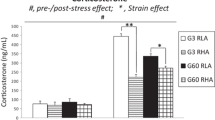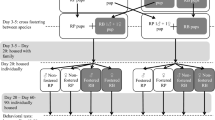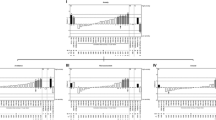Abstract
Recently, two Wistar rat lines, bred and selected for either high (HAB) or low (LAB) anxiety-related behavior on the elevated plus-maze, were described as a novel psychopathologic animal model. The behavioral and neuroendocrine responses to exposure to an emotional stressor were markedly enhanced in HAB rats compared with LAB rats, thus resembling patients suffering from psychiatric diseases. The present study focused on the developmental and genetic basis of the line-specific differences by using cross-fostering and cross-breeding approaches. For the cross-fostering paradigm, neonate HAB offspring were nursed by a LAB foster mother, and vice versa, until weaning. In the cross-breeding approach, HAB females were mated with LAB males, and vice versa, to create an intermediate F1 generation. Thereafter, the F1 animals were strictly sibling-mated to produce a segregating F2 generation. At 10 weeks of age, anxiety-related behavior of all animals was tested on the elevated plus-maze. The robustness of emotionality was assessed in rats of both lines throughout their entire lifetime. Serving this purpose, the frequency of ultrasound isolation calls, indicative of the emotionality of newborn rats, was monitored in regularly-fostered HAB and LAB pups on postnatal day 11. In addition, the timecourse of anxiety-related behavior was studied by repeated testing on the elevated plus-maze at the ages of 10 weeks, 6 months, 16 months, and 19 months. The cross-fostering approach failed to reveal behavioral differences between regularly and cross-fostered HAB and LAB rats, indicating no line-specific differences in maternal care or maternally-influenced development, at least after postnatal day 1. In contrast, cross-breeding resulted in F1 and F2 offspring displaying intermediate behavioral patterns on the elevated plus-maze which were exactly in between those shown in HAB and LAB control rats, thus confirming a genetic basis of the differences in anxiety. Cross-breeding revealed no differences related to the gender of the offspring or to the line-derivation of sire or dam, indicating an autosomal, rather than heterosomal, heredity of the divergent emotionality in HABs and LABs. Further, we were able to show stable and robust emotional differences in rats of both lines during their entire lifetime. HAB rats showed an enhanced frequency of ultrasound isolation calls on postnatal day 11 (p < 0.05) and a lower open arm exploration of the elevated plus-maze throughout adulthood (p < 0.01) compared with the same-aged LABs. In conclusion, the extremely divergent anxiety levels of HAB and LAB rats are maintained during their whole lives and are determined genetically, rather than being learned. These findings may be important for further studies on the genetic basis of emotionality.
Similar content being viewed by others
REFERENCES
Andreatini, R., and Bacellar, L. F. (2000). Animal models: Trait or state measure? The test re-test reliability of the elevated plusmaze and behavioural despair. Prog Neuropsychopharmacol Biol. Psychiat. 24: 549–560.
Bertoglio, L. J., and Carobrez, A. P. (2000). Previous maze experience required to increase open arms avoidance in rats submitted to the elevated plus-maze model of anxiety. Behav. Brain Res. 108: 197–203.
Broadhurst, P. L. (1969). Psychogenetics of emotionality in the rat. Ann. NY Acad. Sci. 159: 806–824.
Brunelli, S. A., Vinocur, D. D., Soo-Hoo, D., and Hofer, M. A. (1977). Five generations of selective breeding for ultrasonic vocalization (usv) responses in the N:NIH strain rats. Dev. Psychobiol. 31: 255–265.
Caldji, C., Tannenbaum, B., Sharma, S., Francis, D., Plotsky, P. M., and Meaney, M. J. (1998). Maternal care during infancy regulates the development of neural systems mediating the expression of fearfulness in the rat. Proc. Natl. Acad. Sci. USA, 95: 5335–5340.
Cameron, O. G., and Nesse, R. M. (1988). Systemic hormonal and physiological abnormalities in anxiety disorders. Psychoneuroendocrinology 13: 287–307.
Castanon, N., Perez-Diaz, F., and Mormède, P. (1995). Genetic analysis of the relationships between behavioral and neuroendocrine traits in roman high and low avoidance rat lines. Behav. Genet. 25: 371–384.
Cierpial, M. A., and McCarthy, R. (1991). Adult blood pressure reduction in spontaneously hypertensive rats reared by normotensive sprague-dawley mothers. Behav. Neural Biol. 56: 262–270.
Cierpial, M. A., Murphy, C. A., and McCarthy, R. (1990). Maternal behaviour of spontaneously hypertensive and wistar-kyoto normotensive rats: Effects of reciprocal cross-fostering of litters. Behav. Neural Biol. 54: 90–96.
Cierpial, M. A., Shasby, D. E., Murphy, C. A., Borom, A. H., Stewart, R. E., Swithers, S. E., and McCarthy, R. (1989). Open-field behaviour of spontaneously hypertensive and wistar-kyoto normotensive rats: Effects of reciprocal cross-fostering of litters. Behav. Neural Biol. 51: 203–210.
Dawson, G. R., Crawford, S. P., Collison, N., Iverson, S. D., and Tricklebank, M. D. (1995). Evidence that the anxiolytic-like effects of chlordiazepoxide on the elevated plus-maze are confounded by increases in locomotor activity. Psychopharmacology 118: 316–323.
Dichter, G. S., Brunelli, S. A., and Hofer, M. A. (1996). Elevated plusmaze behaviour in adult offspring of selectively bred rats. Physiol. Behav. 60: 299–304.
Driscoll, P., and Bättig, K. (1982). Behavioral, emotional and neurochemical profiles of rats selected for extreme differences in active, two-way avoidance performance. In I. Liebich (ed.), Genetics of the brain, Amsterdam: Elsevier Biomed, pp. 95–123.
Driscoll, P., Escorihuela, R. M., Fernández-Teruel, A., Giorgi, M. G., Schwegler, H., Steimer, Th., Wiersma, A., Corda, M. G., Flint, J., Koolhaas, J. M., Langhans, W., Schulz, P. E., Siegel, J., and Tobena, A. (1998). Genetic selection and differential stress responses: The roman lines/strains of rats. Ann. NY Acad. Sci. 851: 501–510.
Fernandes, C., Gonzalez, M. I., Wilson, C. A., and File, S. E. (1999). Factor analysis shows that female rat behaviour is characterized primarily by activity, male rats are driven by sex and anxiety. Pharmacol. Biochem. Behav. 64: 731–738.
Fernandez-Teruel, A., Escorihuela, R. M., Castellano, B., Gonzalez, B., and Tobena, A. (1997). Neonatal handling and environmental enrichment effects on emotionality, novelty/reward seeking, and age-related cognitive and hippocampal impairments: Focus on the Roman rat lines. Behav. Genet. 27: 513–526.
Flint, J., Corley, R., DeFries, J. C., Fulker, D. W., Gray, J. A., Miller, S., and Collins, A. C. (1995). A simple genetic basis for a complex psychological trait in laboratory mice. Science 269: 1432–1435.
Frussa-Filho, R., Otoboni, J. R., Uema, F. T., and Sa-Rocha, L. C. (1991). Evaluation of memory and anxiety in rats observed in the elevated plus-maze: Effects of age and isolation. Braz. J. Med. Biol. Res. 24: 725–728.
Gershenfeld, H. K., and Paul, S. M. (1997). Mapping quantitative trait loci for fear-like behaviours in mice. Genomics 46: 1–8.
Gershenfeld, H. K., and Paul, S. M. (1998). Towards a genetics of anxious temperament: From mice to men. Acta Psychiatr. Scand. 98: 56–65.
Gora-Maslak, G., McClearn, G., Crabbe, J. C., Phillips, T. J., Belknap, J. K., and Plomin, R. (1991). Use of recombinant inbred strains to identify quantitative trait loci in psychopharmacology. Psychopharmacology 104: 413–424.
Heit, S., Owens, M. J., Plotsky, P., and Nemeroff, C. B. (1997). Corticotropin-releasing factor, stress, and depression. Neuroscientist 3: 186–194.
Hendley, E. D., Wessel, D. J., and Van Houten, J. (1986). Inbreeding of wistar-kyoto rat strain with hyperactivity but without hypertension. Behav. Neural. Biol. 45: 1–16.
Henn, F. A. and Edwards, E. (1991). Animal models in the study of genetic factors in human psychopathology. In D. F. Papolos and H. M. Lachman (eds.), New York: The Einstein Psychiatry Series: Genetic Studies in Affective Disorders, Wiley, pp. 177–192.
Henniger, M. S., Ohl, F., Hölter, S. M., Weissenbacher, P., Toschi, N., Lörscher, P., Wigger, A., Spanagel, R., and Landgraf, R. (2000). Unconditioned anxiety and social behaviour in two rat lines selectively bred for high and low anxiety-related behaviour. Behav. Brain Res. 111: 153–163.
Holsboer, F. (1989). Psychiatric implications of altered limbichypothalamic-pituitary-adrenocortical activity. Eur. Arch. Psychiatry Neurol. Sci. 238: 302–322.
Insel, T. R., and Hill, J. L. (1987). Infant separation distress in genetically fearful rats. Biol. Psychiatry 22: 786–789.
Johnston, A. L., and File, S. E. (1991). Sex differences in animal tests of anxiety. Physiol. Behav. 49: 245–250.
Keck, M. E., Wigger, A., Welt, T., Müller, M. B., Gesing, A., Reul, J. M., Landgraf, R., Holsboer, F., and Neumann, I. D. (in press). Vasopressin mediates the response of the combined dexamethasone/ CRH test in hyperanxious rats: implications for pathogenesis of affective disorders. Neuropsychopharmacology.
Kehne, J. H., Coverdale, S., McCloskey, T. C., Hoffman, D. C., and Cassella, J. V. (2000). Effects of the CRF1 receptor antagonist, CP 154,526, in the separation-induced vocalization anxiolytic test in rat pups. Neuropsychopharmacology 39: 1357–1367.
Kendler, K. S., Heath, A. C., Martin, N. G., Eaves, L. J. (1987). Symptoms of anxiety and symptoms of depression: Same genes, different environments? Arch. Surg. 122: 451–457.
Ladd, C. O., Owens, M. J., and Nemeroff, C. B. (1996). Persistent changes in corticotropin-releasing factor neuronal systems induced by maternal deprivation. Endocrinology 137: 1212–1218.
Landgraf, R., Wigger, A., Holsboer, F., and Neumann, I. D. (1999). Hyper-reactive hypothalamo-pituitary-adrenocortical axis in rats bred for high anxiety-related behaviour. J. Neuroendocrinol. 11: 405–407.
Liebsch, G., Montkowski, A., Holsboer, F., and Landgraf, R. (1998a). Behavioural profiles of two Wistar rat lines selectively bred for high or low anxiety-related behaviour. Behav. Brain Res. 94: 301–310.
Liebsch, G., Linthorst, A. C. E., Neumann, I. D., Reul, J. M., Holsboer, F., and Landgraf, R. (1998b). Behavioral, physiological, and neuroendocrine stress responses and differential sensitivity to diazepam in two Wistar rat lines selectively bred for high and low anxiety-related behavior. Neuropsychopharmacology 19: 381–396.
Maier, W., and Falkai, P. (1999). The epidemiology of comorbidity between depression, anxiety disorders and somatic diseases. Int Clin. Psychopharmacol. 14: 51–56.
Meaney, M. J., Diorio, J., Francis, D., Widdowson, J., LaPlanta, P., Caldji, C., Sharma, S., Seckl, J. S., and Plotsky, P. M. (1996). Early environmental regulation of forebrain glucocorticoid receptor gene expression: Implications for adrenocortical responses to stress. Dev. Neurosci. 18: 49–72.
Myers, M. M., Brunelli, S. A., Shair, H. N., Squire, J. M., and Hofer, M. A. (1989). Relationships between maternal behaviour of SHR and WKY dams and adult blood pressures of cross-fostered F1 pups. Dev. Psychobiol. 22: 55–67.
Neumann, I., Wigger, A., Liebsch, G., Holsboer, F., and Landgraf, R. (1998). Increased basal activity of the hypothalamo-pituitaryadrenal axis during pregnancy in rats bred for high anxietyrelated behaviour. Psychoneuroendocrinology 23: 449–463.
Ohl, F., Toschi, N., Wigger, A., Henniger, M., and Landgraf, R. (2001). Dimensions of emotionality in a rat model of innate anxiety. Behav. Neurosci. 115: 429–436.
Ohta, R., Matsumoto, A., Nagao, T., and Mizutani, M. (1998). Comparative study of behavioral development between high and low shuttlebox avoidance rats. Physiol. Behav. 63: 545–551.
Pellow, S., Chopin, P., File, S. E., and Briley, M. (1985). Validation of open: Closed arms entries in an elevated plus-maze as a measure of anxiety in the rat. J. Neurosci. Methods 14: 149–167.
Plotsky, P. M., and Meaney, M. J. (1993). Early postnatal experience alters hypothalamic corticotropin-releasing factor (CRF) mRNA, median eminence CRF content and stress induced release in adult rats. Brain Res. 18: 195–200.
Raadsheer, F. C., Hoogendijk, W. J. G., Stam, F. C., Tilders, F. J. H., and Swaab, D. F. (1994). Increased numbers of corticotropinreleasing hormone expressing neurons in the hypothalamic paraventricular nucleus of depressed patients. Neuroendocrinology 60: 436–444.
Ramos, A., and Mormède, P. (1998). Stress and emotionality: A multidimensional and genetic approach. Neurosci. Biobehav. Rev. 22: 33–57.
Ressler, K. J., and Nemeroff, C. B. (2000). Role of serotonergic and noradrenergic systems in the pathophysiology of depression and anxiety disorders. Depress Anxiety 12(Suppl 1): 2–19.
Rots, N. Y., de Jong, J., Workel, J. O., Levine, S., Cools, A. R., and DeKloet, E. R. (1996). Neonatal maternally deprived rats have as adults elevated basal pituitary-adrenal activity and enhanced susceptibility to apomorphine. J. Neuroendocrinol. 8: 501–506.
Scherrer, J. F., Truem, W. R., Xian, H., Lyons, M. J., Eisen, S. A., Goldberg, J., Lin, N., and Tsuang, M. T. (2000). Evidence for genetic influences common and specific to symptoms of generalized anxiety and panic. J. Affect Disorders 57: 25–35.
Steimer, T., la Fleur, S., and Schulz, P. E. (1997). Neuroendocrine correlates of emotional reactivity and coping in male rats from the Roman high (RHA/Verh) and low (RLA/Verh)-Avoidance lines. Behav. Gen. 27: 499–508.
Steimer, T., Escorihuela, R. M., Fernandez-Teruel, A., and Driscoll, P. (1998). Long-term behavioural and neuroendocrine changes in Roman high-(RHA/Verh) and low-(RLA-Verh) avoidance rats following neonatal handling. Int. J. Dev. Neurosci. 16: 165–174.
Stein, M. B., Jang, K. L., and Livesley, W. J. (1999). Heritability of anxiety sensitivity: A twin study. Am. J. Psychiatry 156: 246–251.
True, W., Scherrer, W. F., Xian, H., Eisen, S. A., Goldberg, J., Lyons, M., and Tsuang, W. (1997). Evidence for common nonadditive genetic contributions to symptoms of generalized anxiety disorder, panic and posttraumatic stress disorder. Am. J. Med. Genetics 74: 653–653.
Vallée, M., Mayo, W., Dellu, F., Le Moal, M., Simon, H., and Maccari, S. (1997). Prenatal stress induces high anxiety and postnatal handling induces low anxiety in adult offspring: Correlation with stress-induced corticosterone secretion. J. Neurosci. 17: 2626–2636.
Weinstock, M. (1997). Does prenatal stress impair coping and regulation of hypothalamic-pituitary-adrenal axis? Neurosci. Biobehav. Rev. 21: 1–10.
Wigger, A., and Neumann, I. D. (1999). Periodic maternal deprivation induces gender-dependent alterations in behavioral and neuroendocrine responses to emotional stress in adult rats. Physiol. Behav. 66: 293–302.
Winslow, J. T., and Insel, T. R. (1991). Infant rat separation is a sensitive test for novel anxiolytics. Prog. Neuropsychopharmacol. Biol. Psychiatry 15: 745–757.
Author information
Authors and Affiliations
Rights and permissions
About this article
Cite this article
Wigger, A., Loerscher, P., Weissenbacher, P. et al. Cross-Fostering and Cross-Breeding of HAB and LAB Rats: A Genetic Rat Model of Anxiety. Behav Genet 31, 371–382 (2001). https://doi.org/10.1023/A:1012222402346
Issue Date:
DOI: https://doi.org/10.1023/A:1012222402346




